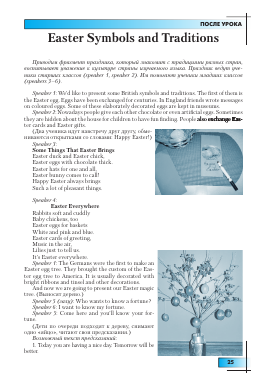Easter Symbols and Traditions
Приводим фрагмент праздника, который знакомит с традициями разных стран, воспитывает уважение к культуре страны изучаемого языка. Праздник ведут ученики старших классов (speaker 1, speaker 2). Им помогают ученики младших классов (speakers 3-6).
Speaker 1: We'd like to present some British symbols and traditions. The first of them is the Easter egg. Eggs have been exchanged for centuries. In England friends wrote messages on coloured eggs. Some of these elaborately decorated eggs are kept in museums.
Speaker 2: Nowadays people give each other chocolate or even artificial eggs. Sometimes they are hidden about the house for children to have fun finding. People also exchange Easter cards and Easter gifts.
(Два ученика идут навстречу друг другу, обмениваются открытками со словами: Happy Easter!) Speaker 3:
Some Things That Easter Brings
Easter duck and Easter chick, Easter eggs with chocolate thick. Easter hats for one and all, Easter bunny comes to call! Happy Easter always brings Such a lot of pleasant things.
Speaker 4:
Easter Everywhere
Rabbits soft and cuddly Baby chickens, too Easter eggs for baskets White and pink and blue. Easter cards of greeting, Music in the air, Lilies just to tell us. It's Easter everywhere.
Speaker 1: The Germans were the first to make an Easter egg tree. They brought the custom of the Easter egg tree to America. It is usually decorated with bright ribbons and tinsel and other decorations.
And now we are going to present our Easter magic tree. (Выносят дерево.)
Speaker 5 (залу): Who wants to know a fortune? Speaker 6: I want to know my fortune. Speaker 5: Come here and you'll know your fortune.
(Дети по очереди подходят к дереву, снимают одно «яйцо», читают свои предсказания.) Возможный текст предсказаний: 1. Today you are having a nice day. Tomorrow will be better.
Us
2. This week you will go to an interesting place. Save money for the trip.
3. Today is the best day of your life. You will take part in the Easter contest.
4. This month you will get a lot of good marks. Your parents will be glad.
5. Soon you will have a party. You will meet a nice girl or boy.
6. You will be lucky. You'll get a nice present from your parents.
7. You will have a good time with your friends.
8. You will celebrate Easter with your new friends. Don't eat too many Easter chocolates.
9. You will celebrate Easter with your relatives. Enjoy some Easter eggs.
10. You will win the prize if you take part in the competitions.
Speaker 2: On Easter Day people traditionally wear new clothes to mark the change of the seasons. Sometimes Easter parades are held on Easter Day including competitions for the best Easter bonnet.
Speaker 1: Many countries have carnivals and processions on Easter Day and throughout a Holy week. Every year London greets the spring with Easter parade in Battersea Park on Easter Sunday. Exotic masks can be made for the carnival. A basic mask can be decorated with seeds or pasta and sprayed with gold paint. The decoration can be anything which will make the mask colourful and interesting. We invite all the pupils to take part in the parade of masks and costumes. (Идет парад масок и костюмов)
Speaker2: Eggs play an important part in Easter sports. Two traditional Easter games are the Easter Egg Roll and the Easter Egg Hunt.
Egg-rolling is a traditional Easter pastime. It takes place on Easter Sunday or Monday and consists of rolling coloured, hard-boiled eggs down a slope until they are cracked and broken after which they are eaten by their owners. The winner is the player whose egg remains longest undamaged, but more usually the fun consists of the rolling and eating. Egg-rolling is not originally a game to be lost or won.
(Пока ведущий рассказывает об этой традиции два ученика младших классов выходят навстречу друг другу, они катают пасхальные яйца по полу с помощью столовой ложки, инсценируя рассказ.)
Speaker 1: The custom of an Easter Egg Hunt began because children believed that rabbits laid eggs in the grass. On Easter Sunday children hunt for the eggs all around the house and the child who finds the most eggs wins a prize.
Speaker 2: And at last we want to treat you with Easter nests. They are made from cereal, chocolate, butter and Easter eggs. Enjoy your treat.
Easter Nests
To make the nests, you need: 250 g breakfast cereal, 2 table spoons golden syrup, 350 g chocolate, 250 g butter, Easter egg sweets.
1. Crush the cereal with a spoon.
2. Then put the chocolate, golden syrup and butter on a plate. Put the plate on a saucepan with hot water in it. Put the saucepan on the cooker and the chocolate will melt.
3. Pour the chocolate onto the cereal. Mix them together with a spoon.
4. Now put the chocolate and the cereal "nests" on a metal tray. Press them down with a spoon.
5. Put the "nests" into the fridge for two hours.
6. Put some Easter egg sweets in the "nests". Enjoy the nests.
A Ring o'Roses
(Венок из роз. Хороводная)
1. A ring, a ring o'roses A pocket full of posies Jump down! Jump down! All fall down.
2. The king has sent his daughter To fetch a pail of water Jump down! Jump down!
All fall down.
3. The robin on the steeple Is singing to the people. Jump down! Jump down! All fall down.
4. The wedding bells are ringing. The boys and girls are singing. Jump down! Jump down!
All fall down.
Т.М. Шарафутдинова
Сведения об авторе: Шарафутдинова Танзиля Махмутовна, учитель английского языка МОУ СОШ № 25, г. Златоуст, Челябинская обл. Email: sh25@mail.ru
Ключевые слова: Easter symbols, traditions, Easter cards, Easter gifts.
Для дальнейшего прочтения статьи необходимо приобрести полный текст. Статьи высылаются в формате PDF на указанную при оплате почту. Время доставки составляет менее 10 минут. Стоимость одной статьи — 150 рублей.
